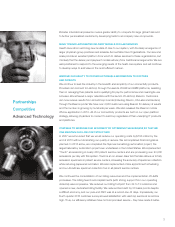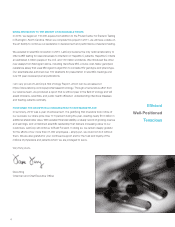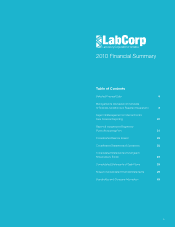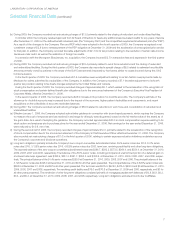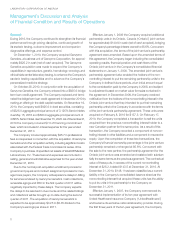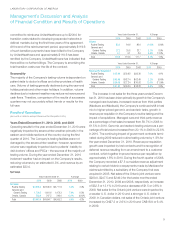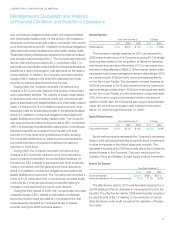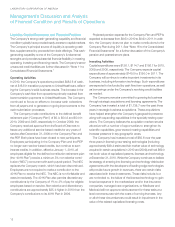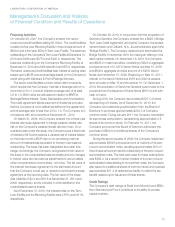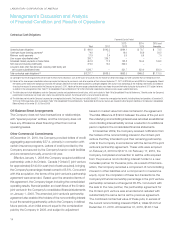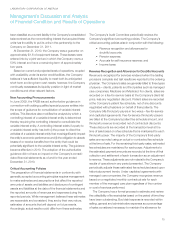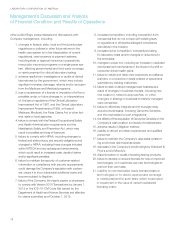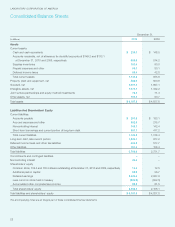LabCorp 2010 Annual Report Download - page 14
Download and view the complete annual report
Please find page 14 of the 2010 LabCorp annual report below. You can navigate through the pages in the report by either clicking on the pages listed below, or by using the keyword search tool below to find specific information within the annual report.12
LABORATORY CORPORATION OF AMERICA
Management’s Discussion and Analysis
of Financial Condition and Results of Operations
Liquidity, Capital Resources and Financial Position
The Company’s strong cash-generating capability and financial
condition typically have provided ready access to capital markets.
The Company’s principal source of liquidity is operating cash
flow, supplemented by proceeds from debt offerings. This cash-
generating capability is one of the Company’s fundamental
strengths and provides substantial financial flexibility in meeting
operating, investing and financing needs. The Company’s senior
unsecured credit facilities are further discussed in “Note 11 to
Consolidated Financial Statements.”
Operating Activities
In 2010, the Company’s operations provided $883.6 of cash,
net of $16.8 in transition payments to UnitedHealthcare, reflect-
ing the Company’s solid business results. The increase in the
Company’s cash flow from operations primarily resulted from
lower transition payments to UnitedHealthcare. The Company
continued to focus on efforts to increase cash collections
from all payers and to generate on-going improvements to the
claim submission processes.
The Company made contributions to the defined benefit
retirement plan (“Company Plan”) of $0.0, $54.8 and $0.0 in
2010, 2009 and 2008, respectively. In October 2009, the
Company received approval from its Board of Directors to
freeze any additional service-based credits for any years of
service after December 31, 2009 on the Company Plan and
the PEP. Both plans have been closed to new participants.
Employees participating in the Company Plan and the PEP
no longer earn service-based credits, but continue to earn
interest credits. In addition, effective January 1, 2010, all
employees eligible for the defined contribution retirement plan
(the “401K Plan”) receive a minimum 3% non-elective contri-
bution (“NEC”) concurrent with each payroll period. The NEC
replaces the Company match, which has been discontinued.
Employees are not required to make a contribution to the
401K Plan to receive the NEC. The NEC is non-forfeitable and
vests immediately. The 401K Plan also permits discretionary
contributions by the Company of 1% to 3% of pay for eligible
employees based on service. Non-elective and discretionary
contributions are approximately $25.4 higher in 2010 than the
Company’s contributions to its 401K Plan in 2009.
Projected pension expense for the Company Plan and PEP is
expected to decrease from $9.6 in 2010 to $8.9 in 2011. In addi-
tion, the Company does not plan to make contributions to the
Company Plan during 2011. See “Note 16 to the Consolidated
Financial Statements” for a further discussion of the Company’s
pension and postretirement plans.
Investing Activities
Capital expenditures were $126.1, $114.7 and $156.7 for 2010,
2009 and 2008, respectively. The Company expects capital
expenditures of approximately $140.0 to $150.0 in 2011. The
Company will continue to make important investments in its
business, including information technology. Such expenditures
are expected to be funded by cash flow from operations, as well
as borrowings under the Company’s revolving credit facilities
as needed.
The Company remains committed to growing its business
through strategic acquisitions and licensing agreements. The
Company has invested a total of $1,738.7 over the past three
years in strategic business acquisitions. These acquisitions
have helped strengthen the Company’s geographic presence
along with expanding capabilities in the specialty testing oper-
ations. The Company believes the acquisition market remains
attractive with a number of opportunities to strengthen its
scientific capabilities, grow esoteric testing capabilities and
increase presence in key geographic areas.
The Company has invested a total of $50.6 over the past
three years in licensing new testing technologies (including
approximately $49.4 estimated fair market value of technology
acquired in certain acquisitions in 2010 and 2009) and had $69.0
net book value of capitalized patents, licenses and technology
at December 31, 2010. While the Company continues to believe
its strategy of entering into licensing and technology distribution
agreements with the developers of leading-edge technologies
will provide future growth in revenues, there are certain risks
associated with these investments. These risks include, but
are not limited to, the failure of the licensed technology to gain
broad acceptance in the marketplace and/or that insurance
companies, managed care organizations, or Medicare and
Medicaid will not approve reimbursement for these tests at a
level commensurate with the costs of running the tests. Any
or all of these circumstances could result in impairment in the
value of the related capitalized licensing costs.



